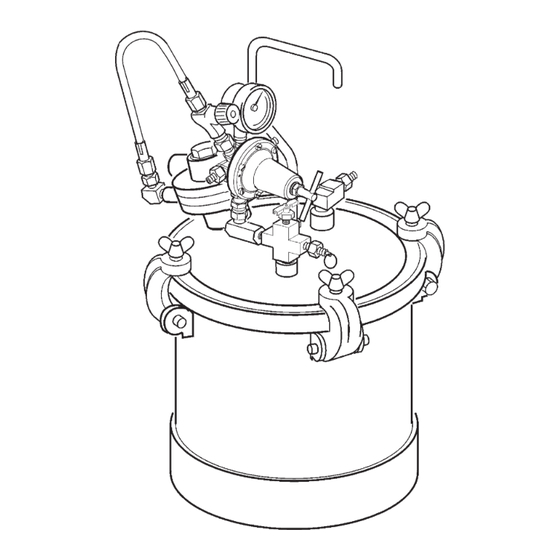Table of Contents
Advertisement
Quick Links
SERVICE MANUAL
EN
IMPORTANT:
Read and follow all
instructions and SAFETY PRECAU-
TIONS before using this equipment.
Retain for future reference.
DESCRIPTION
The 83Z pressure tanks are designed as a
pressure container to supply liquid mate-
rial at a constant preset pressure up to a
maximum of 80 PSI. The tanks are built to
ASME specifications. All models include
stainless steel wetted parts, a stainless steel
lid and polyethylene liner, allowing use with
waterborne materials. All models are for
light to medium duty use only.
Models:
83Z-210: Single regulation (fluid), air inlet/
outlet, fluid outlet, safety valve
83Z-220: Dual regulation (air and fluid),
otherwise same as 83Z-210
83Z-211: Single regulation (fluid), air driven
agitator assembly, fluid outlet, safety valve
83Z-221: Dual regulation (air and fluid),
otherwise same as 83Z-211
PROP 65 WARNING
WARNING: This product
CA PROP
65
contains chemicals known
to the State of California to
cause cancer and birth
defects or other
reproductive harm.
SBBI-21-043-N (6/2017)
83Z PRESSURE TANK
(WATERBORNE COMPATIBLE)
Small Tank – Up To 2.8 Gallons
Halogenated hydrocarbon solvents
- for example: 1,1,1, - trichloroeth-
ane and methylene chloride - can
chemically react with aluminum
parts and components and cause
an explosion hazard. These solvents
will also corrode the galvanized
tank coating. Read the label or data
sheet for the material. Do not use
materials containing these solvents
with these pressure tanks.
Refer to specifications chart to en-
sure that fluids and solvents being
used are chemically compatible
with the tank wetted parts. Before
placing fluids or solvents in tank,
always read accompanying manu-
facturer's literature.
Air pressure loads that are higher
than design loads, or changes to the
pressure feed tank can cause the
tank to rupture or explode.
• A safety valve protects the tank
from over pressurization. During
each use pull the ring on the safety
valve to make sure it operates freely
and relieves air pressure. If the valve
is stuck, does not operate freely,
or does not relieve air pressure, it
must be replaced. Do not eliminate,
make adjustments or substitutions
to this valve.
• Changes to the air tank will weaken
it. Never drill into, weld or change
the tank in any way.
• The maximum working pressure
of this tank is 80 psi.
1 / 8
Static electricity is created by the
flow of fluid through the pressure
tank and hose. If all parts are not
properly grounded, sparking may
occur. Sparks can ignite vapors
from solvents and the fluid being
sprayed.
If static sparking, or slight shock, is
experienced while using this equip-
ment, stop spraying immediately.
Ground the pressure tank by connect-
ing one end of a 12 gauge minimum
ground wire to the pressure tank and
the other end to a true earth ground.
Local codes may have additional
grounding requirements.
See illustration, page 4, for grounding
and grounding hardware required.
Pressure Relief Procedure
High pressure can cause a serious
injury. Pressure is maintained in
a pressure tank after the system
has been shut down. Before at-
tempting removal of fill plug or
cover, pressure must be relieved
using the following steps:
1. Turn off the main air supply
to the tank.
2. Shut off air regulator or re-
move air supply line from tank.
3. Bleed off air in the tank by
turning the air relief valve thumb
screw counterclockwise. Wait un-
til all the air has escaped through
the valve before removing the
pressure tank cover or fill plug.
4. Leave the air relief valve open
until you have reinstalled the
cover.
www.carlisleft.com
Advertisement
Table of Contents

Subscribe to Our Youtube Channel
Summary of Contents for Binks 83Z
- Page 1 DESCRIPTION Pressure Relief Procedure The 83Z pressure tanks are designed as a pressure container to supply liquid mate- High pressure can cause a serious rial at a constant preset pressure up to a injury. Pressure is maintained in maximum of 80 PSI.
- Page 2 SAFETY PRECAUTIONS This manual contains information that is important for you to know and understand. This information relates to USER SAFETY and PREVENTING EQUIPMENT PROBLEMS. To help you recognize this information, we use the following symbols. Please pay particular attention to these sections. Note Important information that tells how to pre- Information that you should pay special...
- Page 3 (P-H-5516) or, with the to control the speed of the agitator. The additional air regulator provided with air motor requires low air consumption, “dual regulation” tank models (83Z-220 approximately 3-6 C.F.M. at 60 P.S.l. (Max. or 83Z-221). input air pressure 100 P.S.l.) See Spray Gun instructions for opera- tion of the gun.
- Page 4 Street Elbow 1/4" NPT (F) x 1/4" NPT (M) n 6 H-2008 Nipple 1/4" NPT(M) (83Z 210&220) Fluid Out x 1/4"NPS(M) (83Z 211 & 221) 7 HA-57011 Hose Assembly 8 HAV-500 Air Adjusting Valve1/4" NPS (F) x 1/4" NPS (M)
- Page 5 #PT-419 Agitator Shaft Assembly not included in KK-5006 Strainer Screen & Felt Kit. with PT-427 Assembly. Must be ordered sepa- ▫ Parts are included in KK-5074 Air Motor Adapter Kit rately. for 83C and 83Z Series tanks. SBBI-21-043-N (6/2017) 5 / 8 www.carlisleft.com...
- Page 6 7. Turn on the air supply to spray gun. 8. Place cloth over air cap on the gun and pull trigger. This will force material back through the hose, into the tank. Binks Solvent Saver 83 G3-5200 can be used to clean hoses and gun fluid passage 9.
- Page 7 NOTES SBBI-21-043-N (6/2017) 7 / 8 www.carlisleft.com...
- Page 8 ©2017 Carlisle Fluid Technologies, Inc. All rights reserved. Binks is part of Carlisle Fluid Technologies, a global leader in innovative finishing technologies. For technical assistance or to locate an authorized distributor, contact one of our international sales and customer support locations.





Need help?
Do you have a question about the 83Z and is the answer not in the manual?
Questions and answers